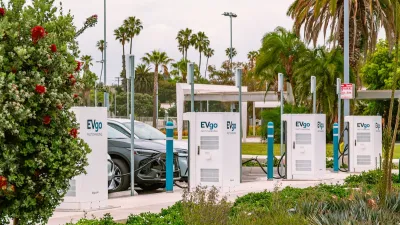Funded through the Bipartisan Infrastructure Law, the Electric Vehicle Charger Reliability and Accessibility grant program will help advance the Biden Administration’s goal to have 500,000 public EV chargers in operation by 2030.

According to an article from Electrek, the U.S. Joint Office of Energy and Transportation has launched a $150 million grant program to repair and upgrade 4,500 existing, publicly accessible electric vehicle charging ports across the country. The effort, called the Electric Vehicle Charger Reliability and Accessibility program, is funded through the Bipartisan Infrastructure Law and is part of the Biden Administration’s goal to have 500,000 public EV chargers in the ground and operating by 2030 and, article author Michelle Lewis reports, “at a time when, according to the US Department of Energy’s Alternative Fuels Data Center, approximately 5% of public charging ports are temporarily unavailable.”
The Joint Office broke ground on the first project funded under the EVC-RAA grant program in late August; the inoperable charging station in Washington, D.C. will be upgraded to charge four vehicles simultaneously at speeds of 150 kW, up from its previous capacity of 50 kW. “Located near a convenience store, a riverfront park, trails, and a Capital Bikeshare station, the station is well-positioned to serve both residents and visitors,” Lewis writes.
In addition to ensuring Americans have access to convenient, safe, and dependable EV charging infrastructure, the federal government’s push to build out EV charging infrastructure is a key component of its strategy to meet national climate goals under the Paris Agreement. Earlier this year, the White House announced $623 million in grants to build new public EV charging infrastructure.
FULL STORY: The US govt is fixing and upgrading 4,500 EV charging ports

Americans May Be Stuck — But Why?
Americans are moving a lot less than they once did, and that is a problem. While Yoni Applebaum, in his highly-publicized article Stuck, gets the reasons badly wrong, it's still important to ask: why are we moving so much less than before?

Using Old Oil and Gas Wells for Green Energy Storage
Penn State researchers have found that repurposing abandoned oil and gas wells for geothermal-assisted compressed-air energy storage can boost efficiency, reduce environmental risks, and support clean energy and job transitions.

Placekeeping: Setting a New Precedent for City Planners
How a preservation-based approach to redevelopment and urban design can prevent displacement and honor legacy communities.

San Francisco’s Muni Ridership Grew in 2024
The system saw its highest ridership since before the Covid-19 pandemic, but faces a severe budget shortage in the coming year.

Colorado Lawmakers Move to Protect BRT Funding
In the face of potential federal funding cuts, CDOT leaders reasserted their commitment to planned bus rapid transit projects.

Safe Streets Funding in Jeopardy
The Trump administration is specifically targeting bike infrastructure and other road safety projects in its funding cuts.
Urban Design for Planners 1: Software Tools
This six-course series explores essential urban design concepts using open source software and equips planners with the tools they need to participate fully in the urban design process.
Planning for Universal Design
Learn the tools for implementing Universal Design in planning regulations.
Heyer Gruel & Associates PA
City of Moreno Valley
Institute for Housing and Urban Development Studies (IHS)
City of Grandview
Harvard GSD Executive Education
Salt Lake City
NYU Wagner Graduate School of Public Service
City of Cambridge, Maryland





























